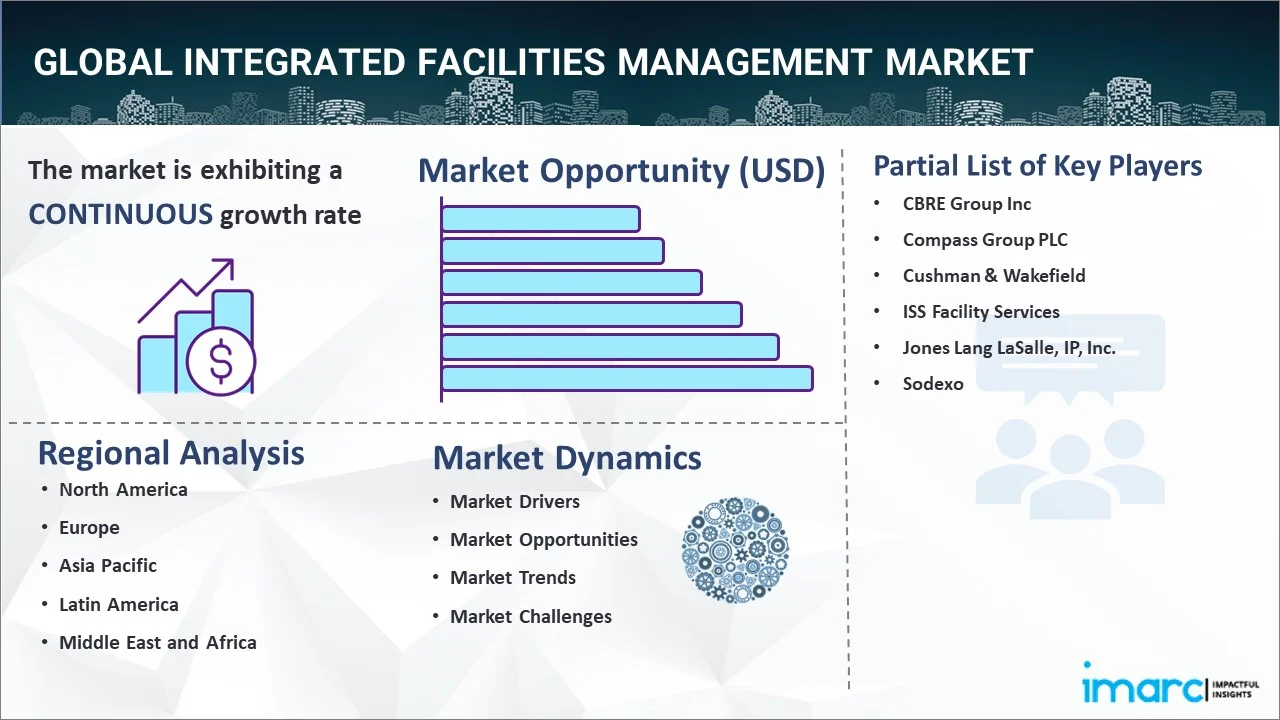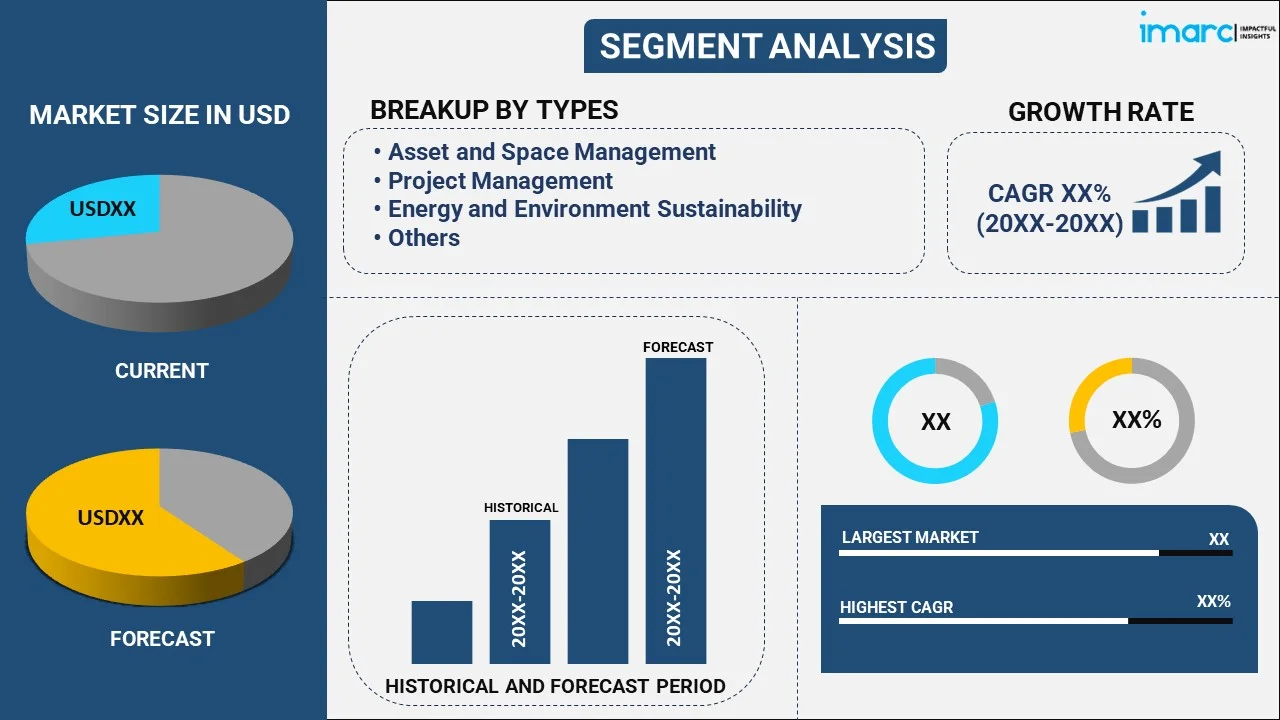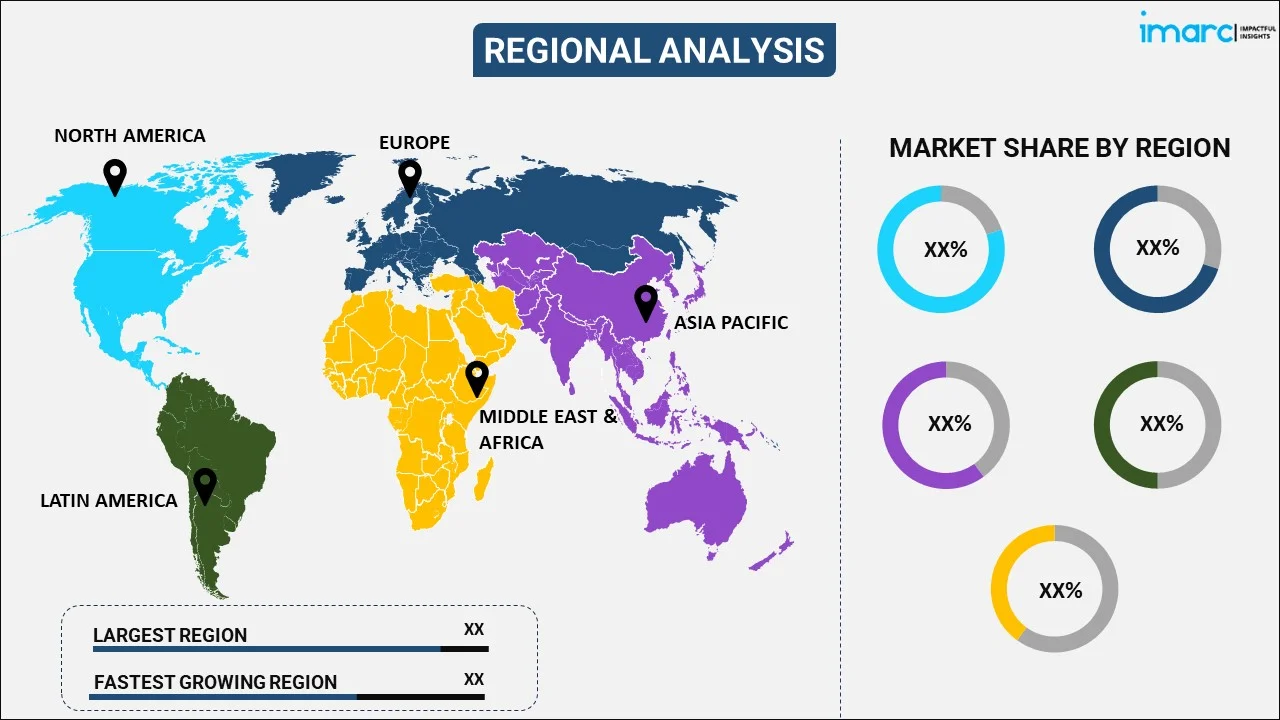
Integrated Facilities Management Market Report by Type (Asset and Space Management, Project Management, Real Estate Portfolio Management and Lease Administration, Energy and Environment Sustainability, Maintenance Management, and Others), Sourcing Model (In house FM, Single FM, Bundled FM, Integrated FM), Service (Soft Service, Hard Service), End Use (Public and Infrastructure, Commercial, Industrial, Institutional, and Others), and Region 2025-2033
Integrated Facilities Management Market Size & Share Analysis:
The global integrated facilities management market size reached USD 119.7 Billion in 2024. Looking forward, IMARC Group expects the market to reach USD 200.8 Billion by 2033, exhibiting a growth rate (CAGR) of 5.62% during 2025-2033. The cost efficiency, focus on core business, and integrated service delivery represent some of the key factors driving the market.
|
Report Attribute
|
Key Statistics |
|---|---|
|
Base Year
|
2024 |
|
Forecast Years
|
2025-2033
|
|
Historical Years
|
2019-2024
|
| Market Size in 2024 | USD 119.7 Billion |
| Market Forecast in 2033 | USD 200.8 Billion |
| Market Growth Rate (2025-2033) | 5.62% |
Integrated Facilities Management (IFM) is a comprehensive approach to managing and maintaining the physical infrastructure and services of an organization. It involves the seamless integration of multiple functions and services to ensure the effective and efficient operation of a facility or a portfolio of facilities. IFM encompasses a wide range of activities, including facility maintenance, space planning, asset management, energy management, vendor management, and security services. The goal is to optimize the use of resources, minimize costs, and create a safe and productive environment for occupants. Furthermore, IFM takes a proactive approach to facility management by focusing on long-term planning and continuous improvement. It involves strategic decision-making based on data-driven insights, regular assessment of facilities' conditions, and the implementation of preventive maintenance programs. In recent years, IFM has gained momentum as it helps mitigate risks, reduce downtime and extend the lifespan of assets by identifying potential issues early on and addressing them promptly.

Integrated Facilities Management Market Trends:
One of the primary factors driving the market is the potential for cost savings offered by IFM. IFM providers leverage their expertise, technology, and vendor networks to optimize resource allocation, negotiate favorable contracts, and implement efficient maintenance and service delivery models. Additionally, organizations are increasingly recognizing the value of outsourcing non-core activities, such as facility maintenance and management. By partnering with IFM providers, businesses can redirect their internal resources and expertise toward their core competencies, enhancing productivity and competitive advantage. IFM also allows companies to rely on specialized professionals to handle facility-related tasks, freeing up their time and resources for strategic initiatives. Other than this, IFM offers a unified and integrated approach to service delivery. Organizations rely on a single point of contact to manage various services, such as maintenance, and cleaning, security, instead of engaging multiple vendors and contractors independently. This integrated approach improves coordination, communication and accountability, leading to enhanced operational efficiency and customer satisfaction. Besides this, the advancements in technology, particularly in areas like building automation, IoT, data analytics, and cloud computing, are driving the market growth. These technologies enable the monitoring and control of facilities in real-time, predictive maintenance, energy optimization, and data-driven decision-making. IFM providers leverage these technologies to deliver innovative solutions, improve service quality, and provide valuable insights to clients for better facility management. In line with this, the growing emphasis on sustainability and environmental responsibility is another growth-inducing factor, as IFM providers play a crucial role in helping organizations achieve their sustainability goals by implementing energy management strategies, monitoring and reducing resource consumption, and implementing eco-friendly practices. Moreover, IFM providers have the expertise and knowledge to ensure facilities adhere to applicable regulations, codes, and standards. They also help organizations mitigate risks by implementing robust security measures, emergency preparedness plans, and ensuring the safety of occupants and assets. These factors are expected to create a positive market outlook in the coming years.
Integrated Facilities Management Market Segmentation:
IMARC Group provides an analysis of the key trends in each segment of the global integrated facilities management market report, along with forecasts at the global, regional, and country levels for 2025-2033. Our report has categorized the market based on the type, sourcing model, service, and end use.
Type Insights:

- Asset and Space Management
- Project Management
- Real Estate Portfolio Management and Lease Administration
- Energy and Environment Sustainability
- Maintenance Management
- Others
The report has provided a detailed breakup and analysis of the integrated facilities management market based on the type. This includes asset and space management, project management, real estate portfolio management and lease administration, energy and environment sustainability, maintenance management, and others.
Sourcing Model Insights:
- In house FM
- Single FM
- Bundled FM
- Integrated FM
A detailed breakup and analysis of the integrated facilities management market based on the sourcing model has also been provided in the report. This includes in house FM, single FM, bundled FM, and integrated FM.
Service Insights:
- Soft Service
- Hard Service
The report has provided a detailed breakup and analysis of the integrated facilities management market based on the service. This includes soft service and hard service.
End Use Insights:
- Public and Infrastructure
- Commercial
- Industrial
- Institutional
- Others
A detailed breakup and analysis of the integrated facilities management market based on the end use has also been provided in the report. This includes public and infrastructure, commercial, industrial, institutional, and others.
Regional Insights:

- North America
- United States
- Canada
- Europe
- Germany
- France
- United Kingdom
- Italy
- Spain
- Others
- Asia Pacific
- China
- Japan
- India
- South Korea
- Australia
- Indonesia
- Others
- Latin America
- Brazil
- Mexico
- Others
- Middle East and Africa
The report has also provided a comprehensive analysis of all the major regional markets, which include North America (the United States and Canada); Europe (Germany, France, the United Kingdom, Italy, Spain, and others); Asia Pacific (China, Japan, India, South Korea, Australia, Indonesia, and others); Latin America (Brazil, Mexico, and others); and the Middle East and Africa. According to the report, North America was the largest market for integrated facilities management. Some of the factors driving the North America integrated facilities management market included rising focus on operational efficiency, growing emphasis on cost reduction and cost control, and increasing complexity of facility management.
Top Integrated Facilities Management Companies:
The report has also provided a comprehensive analysis of the competitive landscape in the global integrated facilities management market. Competitive analysis such as market structure, market share by key players, player positioning, top winning strategies, competitive dashboard, and company evaluation quadrant has been covered in the report. Also, detailed profiles of all major companies have been provided. Some of the companies covered include:
- CBRE Group Inc.
- Compass Group Plc
- Cushman & Wakefield
- ISS Facility Services
- Jones Lang LaSalle, IP, Inc.
- Sodexo
Kindly note that this only represents a partial list of companies, and the complete list has been provided in the report.
Integrated Facilities Management Market Report Scope:
| Report Features | Details |
|---|---|
| Base Year of the Analysis | 2024 |
| Historical Period | 2019-2024 |
| Forecast Period | 2025-2033 |
| Units | Billion USD |
| Scope of the Report | Exploration of Historical and Forecast Trends, Industry Catalysts and Challenges, Segment-Wise Historical and Predictive Market Assessment:
|
| Types Covered | Asset and Space Management, Project Management, Real Estate Portfolio Management and Lease Administration, Energy and Environment Sustainability, Maintenance Management, Others |
| Sourcing Models Covered | In house FM, Single FM, Bundled FM, Integrated FM |
| Services Covered | Soft Service, Hard Service |
| End Uses Covered | Public and Infrastructure, Commercial, Industrial, Institutional, Others |
| Regions Covered | Asia Pacific, Europe, North America, Latin America, Middle East and Africa |
| Countries Covered | United States, Canada, Germany, France, United Kingdom, Italy, Spain, China, Japan, India, South Korea, Australia, Indonesia, Brazil, Mexico |
| Companies Covered | CBRE Group Inc., Compass Group Plc, Cushman & Wakefield, ISS Facility Services, Jones Lang LaSalle, IP, Inc., Sodexo,etc. |
| Customization Scope | 10% Free Customization |
| Post-Sale Analyst Support | 10-12 Weeks |
| Delivery Format | PDF and Excel through Email (We can also provide the editable version of the report in PPT/Word format on special request) |
Key Questions Answered in This Report:
- How has the global integrated facilities management market performed so far, and how will it perform in the coming years?
- What are the drivers, restraints, and opportunities in the global integrated facilities management market?
- What is the impact of each driver, restraint, and opportunity on the global integrated facilities management market?
- What are the key regional markets?
- Which countries represent the most attractive integrated facilities management market?
- What is the breakup of the market based on the type?
- Which is the most attractive type in the integrated facilities management market?
- What is the breakup of the market based on the sourcing model?
- Which is the most attractive sourcing model in the integrated facilities management market?
- What is the breakup of the market based on service?
- Which is the most attractive service in the integrated facilities management market?
- What is the breakup of the market based on end user?
- Which is the most attractive end user in the integrated facilities management market?
- What is the competitive structure of the global integrated facilities management market?
- Who are the key players/companies in the global integrated facilities management market?
Key Benefits for Stakeholders:
- IMARC’s report offers a comprehensive quantitative analysis of various market segments, historical and current market trends, market forecasts, and dynamics of the integrated facilities management market from 2019-2033.
- The research study provides the latest information on the market drivers, challenges, and opportunities in the global integrated facilities management market.
- The study maps the leading, as well as the fastest-growing, regional markets. It further enables stakeholders to identify the key country-level markets within each region.
- Porter's five forces analysis assist stakeholders in assessing the impact of new entrants, competitive rivalry, supplier power, buyer power, and the threat of substitution. It helps stakeholders to analyze the level of competition within the integrated facilities management industry and its attractiveness.
- Competitive landscape allows stakeholders to understand their competitive environment and provides an insight into the current positions of key players in the market.
Need more help?
- Speak to our experienced analysts for insights on the current market scenarios.
- Include additional segments and countries to customize the report as per your requirement.
- Gain an unparalleled competitive advantage in your domain by understanding how to utilize the report and positively impacting your operations and revenue.
- For further assistance, please connect with our analysts.
 Inquire Before Buying
Inquire Before Buying
 Speak to an Analyst
Speak to an Analyst
 Request Brochure
Request Brochure
 Request Customization
Request Customization




.webp)




.webp)












